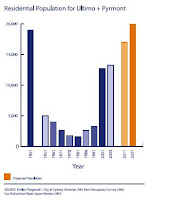









The original inhabitants of the Pyrmont peninsula prior to European settlement were the Cadigal people, who named the area Tumbalong, meaning place where seafood is found. It was not until 1811 that Europeans began to develop a port facility in the area to receive fresh produce from Parramatta and the New South Wales north coast. The port function continued to grow and by 1826 the area was one of the busiest seaports in Australia, which attracted industry to the area. The port facilities, close proximity to the city markets and a growing resident population continued to attract industry to the area. As industry grew so did the transport needs and in 1870 a rail goods yard was built to handle increasing transport requirements of industry.
More workers were attracted to settle in the area close to their employment and by 1900 the residential population had reached 19 000. Pyrmont–Ultimo was at its manufacturing peak and the area acted as an important industrial area from which wool was shipped, sugar refined, flour milled, and electricity generated for the city. Between 1939 and 1945 the Second World War changed the area, with the ports handling war supplies. After the war the area became the point of entry to Australia for post-war migrants. The importance of manufacturing began to decline as many of the manufacturing activities moved to the suburbs.
In the 1970s, when the Port Botany container handling facilities were developed, the cargo handling facilities of the Pyrmont area became obsolete, sending the entire area into urban decay with warehouses empty, shipping in decline, finger wharves demolished and trains no longer servicing the ports. By 1981 the population had fallen to 1590 people.
In 1984, the state government began a program of redevelopment of the area and by 1988 the redeveloped Darling Harbour Precinct made it a central part of the Australian Bicentennial celebrations with the area emerging as a vibrant retail, commercial and tourism precinct. Government influence continued with the City West Development Corporation being formed in 1992 with the specific task of renewing the entire Pyrmont–Ultimo area. Its aim was to increase the residential population and workforce by developing both residential and commercial facilities.
In 1998–99 a total of AU$1.5 billion was spent on the area in the lead up to the 2000 Olympic Games in Sydney. This enabled the harbourside area to become the focus of entertainment and tourism for the duration of the games. This function continued in 2003 when Australia hosted the Rugby World Cup. In 1999 a planning change occurred when the Sydney Harbour Foreshore Authority was formed by the state government to replace the role of the City West
Development Corporation. This new authority then oversaw the remaining development of the Pyrmont–Ultimo area.


















